Teen Health
Iowa AAP received funding from the AAP in support of the Healthy People 20/20 goal to address health literacy and healthy behaviors among Iowa adolescents. The purpose was to engage and educate youth ages 12-18 around identified, targeted health-related issues through technology and social media. There are more than 200,000 Iowans between the ages of 12 and 18 years, and 95% of these adolescents use the Internet regularly (U.S. Census Bureau, 2008). More than 80% use social networking sites, and 31% use the Internet to get information about health and wellness issues (Pew Research Center, 2011). This makes social media sites an ideal platform to communicate with adolescents about health and wellness in order to help them make informed choices. Many Iowa teens live in rural areas where their phones, which have data plans and wireless options, may be the most reliable source of Internet access. In fact, 25% of Iowa teens report that their phones are their main source of Internet access (Pew Research Center, 2013). Through messages posted on social media sites and QR code posters, Iowa AAP aims to distribute quick, teen-friendly messages that can be easily accessed on a mobile phone.
Social Media Sites
Iowa AAP created accounts on four popular social media sites, using the name Iowa’s Health and Wellness Connection for Teens, or “iHAWC”. The information shared on the Facebook, Twitter, Pinterest, and Instagram pages addressed a range of topics including:
- Overweight adolescents/adolescents at risk for obesity
- Adolescent girls using indoor tanning beds
- Adolescents using performance enhancing drugs/substances
- Adolescents with body issues/body concerns
- Adolescents at risk for bullying/hazing
- Potential for flu exposure
- Sexual Health
- Safe Teen Driving
The messages shared on the social media pages were informed through focus groups with Iowa rural and urban adolescents in middle schools, high schools, and an after school group. Focus group participants helped identify which social media platforms were most likely to be effective and which health topics they find most important. At the end of each focus group session, participants filled out written surveys to further inform Iowa AAP about what health topics teens might find important. Iowa AAP also participated in a day-long wellness event at a junior high, where over 60 students learned about being savvy consumers of e-health information. These students participated in the iHAWC social media sites by creating videos and posts that were uploaded to the iHAWC Facebook page.
In April 2014, Iowa AAP presented the project at the annual meeting of the Iowa School Nurse Organization (ISNO). Approximately 100 school nurses heard the presentation and also participated in table-based focus groups. The focus groups provided additional information on what topics to cover in social media posts. Finally, pediatricians filled out written surveys informing Iowa AAP of what information they find most important for teens and which topics could be best addressed on a social media platform.
In order to keep teens engaged with the messages shared on the social media sites, Iowa AAP held photo contests where teens created and shared their own messages about staying healthy. From October through December, teens participated in the “iHAWC Safe Driving Moment Photo Contest” where they posted photos demonstrating what it looks like to be a safe driver. During the month of March, teens participated in the “Sun Safety Contest” where they posted photos showing what they do to stay safe and healthy while in the sun. Teens voted on their favorite photo through Facebook. Contest winners received gift cards. The contests encouraged teens to think about what they and their peers do to stay healthy.
Facebook: Iowa's Health and Wellness Connection for Teens
Twitter: Follow @ihawc4teens
Pinterest: Follow Iowa Health and Wellness Connection for Teens
Instagram: Follow iHAWC
QR Codes
The QR Code posters were informed by the focus groups and surveys conducted for the social media sites. They provided another way for teens to access information quickly and anonymously with their mobile phones. The posters addressed the same topics as the social media sites but they can be hung in classrooms and in the school nurse’s office. After downloading an application used to scan QR codes, teens scanned the codes of the topics and received information on the spot. Though adolescents were using social media to obtain health related information, many adults were less familiar with the environment, and were at a loss as to where to direct adolescents for appealing, and reputable, information. The QR poster in particular has informed project planners about the challenges school nurses face in using technology and social media to influence health behaviors in their students. In order to release the best posters possible, Iowa AAP sent the posters to all school nurses in Iowa, and asked for feedback.
Free high-resolution version of the QR Code posters are available:
Iowa AAP presented information about this project at the 2014 Iowa Governor’s Conference, the annual meeting of the Iowa School Nurse Organization, and The University of Iowa Children’s Hospital Annual Pediatric Conference.

